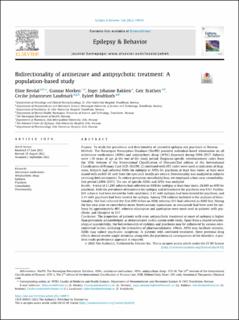| dc.description.abstract | Purpose
To study the prevalence and directionality of comorbid epilepsy and psychosis in Norway.
Methods
The Norwegian Prescription Database (NorPD) provided individual-based information on all antiseizure medications (ASMs) and antipsychotic drugs (APDs) dispensed during 2004–2017. Subjects were ≥18 years of age at the end of the study period. Diagnosis-specific reimbursement codes from the 10th revision of the International Classification of Diseases/2nd edition of the International Classification of Primary Care (ICD-10/ICPC-2) combined with ATC codes were used as indicators of diagnosis. Subjects had collected ASMs for epilepsy or APDs for psychosis at least four times, at least once issued with an ICD-10 code from the specialist healthcare service. Directionality was analyzed in subjects receiving both treatments. To reduce prevalent comorbidity bias, we employed a four-year comorbidity-free period (2004–2007). The use of specific ASMs and APDs was analyzed.
Results
A total of 31,289 subjects had collected an ASM for epilepsy at least four times, 28,889 an APD for psychosis. Both the prevalence of treatment for epilepsy and of treatment for psychosis was 0.8%. Further, 891 subjects had been treated for both conditions; 2.8% with epilepsy had been treated for psychosis, and 3.1% with psychosis had been treated for epilepsy. Among 558 subjects included in the analyses of directionality, 56% had collected the first APD before an ASM, whereas 41% had collected an ASM first. During the last year prior to comorbidity onset, levetiracetam, topiramate, or zonisamide had been used for epilepsy by approximately 40%, whereas olanzapine and quetiapine were most used in patients with psychosis, and clozapine in 13%.
Conclusion
The proportion of patients with prior antipsychotic treatment at onset of epilepsy is higher than previously acknowledged, as demonstrated in this nation-wide study. Apart from a shared neurobiological susceptibility, the bidirectionality of epilepsy and psychosis may be influenced by various environmental factors, including the interaction of pharmacodynamic effects. APDs may facilitate seizures; ASMs may induce psychiatric symptoms. In patients with combined treatment, these potential drug effects should receive ample attention, along with the psychosocial consequences of the disorders. A prudent multi-professional approach is required. | en_US |

